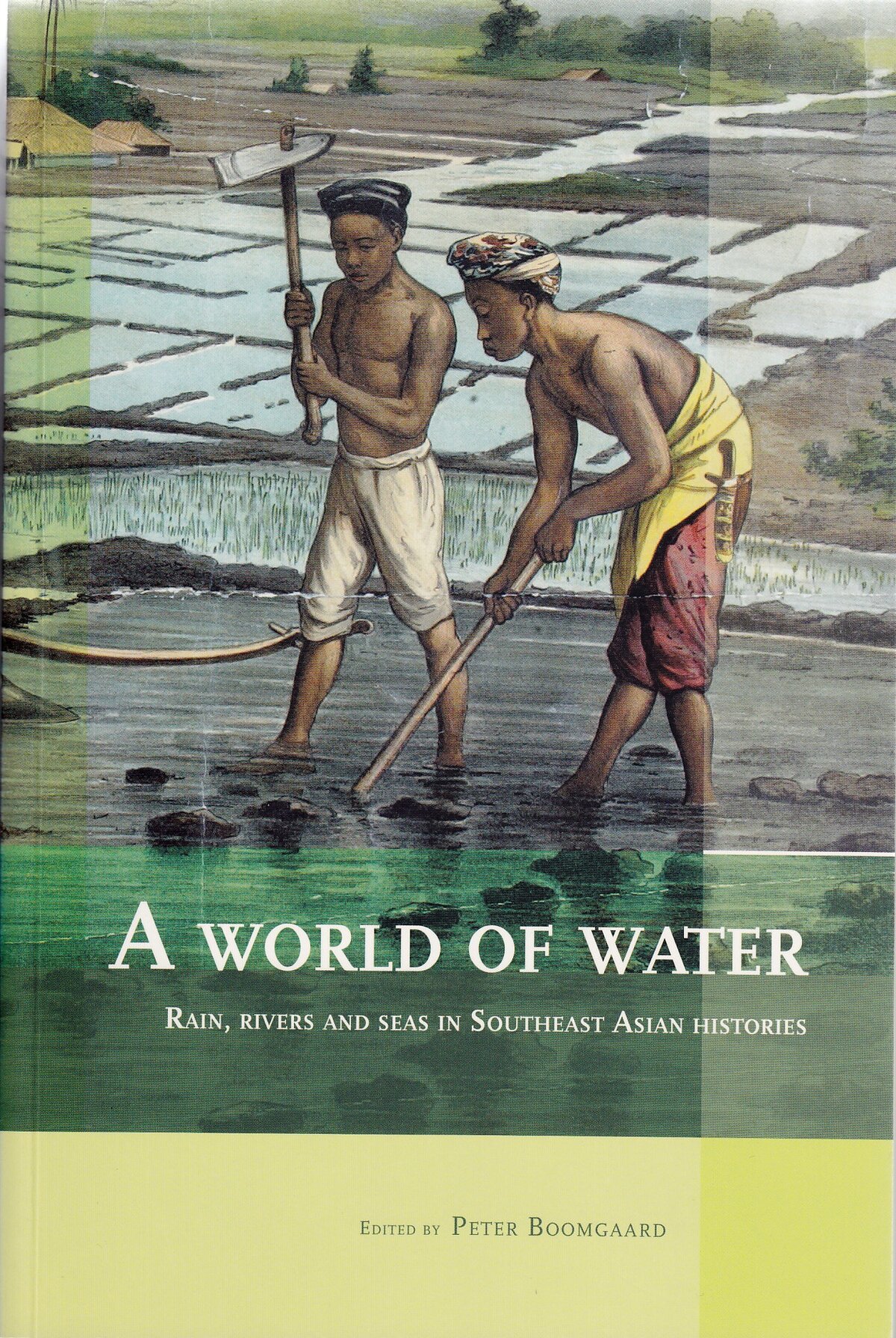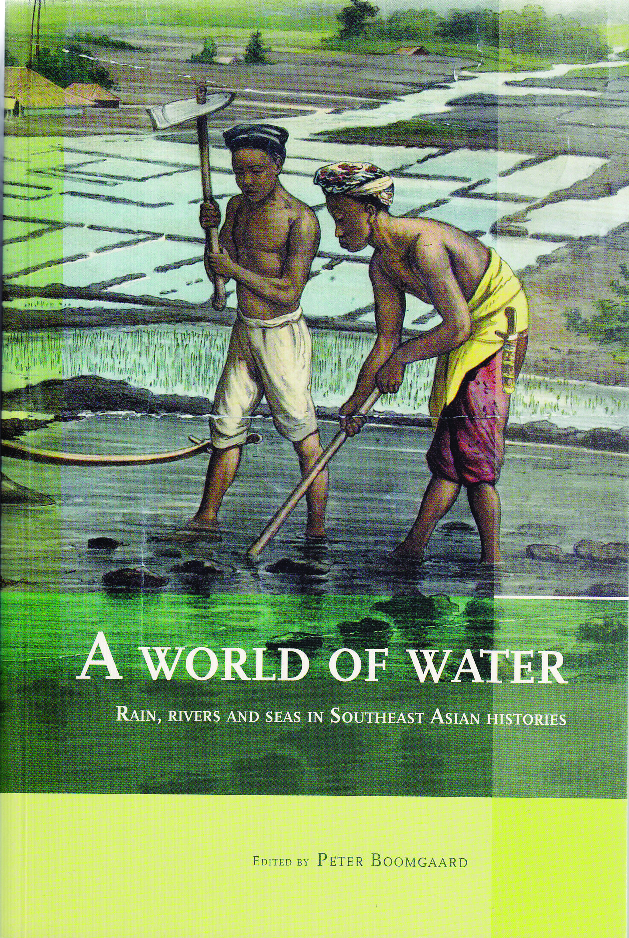A World of Water: Rain, Rivers and Seas in Southeast Asian Histories
by Peter Boomgaard
A crosscultural, multidisciplinary, study on water, its economic and social impact, and its symbolism.

- Format
- e-book
- Publisher
- KITLV Press, Koninklijk Instituut voor Taal-, Land- en Volkenkunde (Royal Netherlands Institute of Southeast Asian and Caribbean Studies), Leiden
- Edition
- digital version
- Published
- 2007
- Author
- Peter Boomgaard
- Pages
- 377
- Language
- English
pdf 3.7 MB
In his preface poetically titled ‘In a state of flux: Water as a deadly and a life-giving force in Southeast Asia’, the late Professor Peter Boomgaard remarks that “there are more than one million irrigation systems in the world and we have empirical descriptions of no more than 200 of these.”
Later in the book, another author notes that “strangely enough, most sites established in Southeast Asia between 1000 BC and 1000 AD were located in low rainfall areas, where some sort of irrigation was a necessity.”
Even if the studies gathered in this volume mostly deal with maritime Southeast Asia, some important insights are presented in regards with the Angkorean state or empire, with an ongoing discussion on
Was Angkor a truly ‘hydraulic’ city and state?
“One group of geographers and archaeologists (Rigg 1992) criticize Wittfogel’s theory on the basis of a number of cases of irrigation systems in Southeast Asia. The most pertinent cases are from semi-arid regions on the continent. Geographer Stott (1992) shows that the Angkor temple complex in Cambodia, with its large system of canals, was not a hydraulic state, as the water from the canals was not used to irrigate the fields. Farmers acquired the water they needed for agriculture in another way. The religious use of water was totally separate from farmers’ use of water. Similarly, archaeologist Stargardt shows for central Burma and southern Thailand that irrigation was organized by farmers. Completely reversing Wittfogel’s argument, these authors attribute irrigation systems not to state interference, but to ‘local irrigation associations’, ‘autonomous local groups’ or ‘irrigation communities’ (Rigg 1992:4, 55, 69).” (Boomgaard)
Revisiting this ongoing discussion among Dutch (and international) scholars, Willem Wolters writes:
“Throughout the centuries farmers have constructed flood-retarding dikes and bunds, as well as small reservoirs using natural depressions in the landscape, to catch the water. Farmers can transplant or broadcast rice immediately after the retreat of the flood, and harvest in February or March. Archaeologist and irrigation engineer Van Liere (1980) has described ‘receding flood’ agriculture for the area around Angkor, bordering the Great Lake in Cambodia, where farmers used the annual incursion and retreat of water from the Siem Reap River (a tributary of the Mekong River) [???] and the lake, and for the floodplains of the Mun and Chin rivers (tributaries of the Mekong River) in northeast Thailand.
“Van Liere (1980) has shown that the theocratic superstructure of Angkor, the system of a divine king, a large priesthood, sacred temples and monasteries, temple ponds and canals, moats around the city, in short the whole system of theocratic hydraulics, was totally disconnected from agriculture. The canals supplying water to the temples did not bring water to the fields. Van Liere argues that theocratic hydraulics was technologically limited, as it was not possible to build permanent weirs in monsoon rivers or clay dams around reservoirs. The dams were small earthworks on minor streams in the foothills nearby. Generalizing from Van Liere’s analysis, geographer Stott (1992) has argued that Wittfogel’s hydraulic paradigm must be replaced by a new paradigm of local management of water. He considers flood-retreat agriculture as a brilliant farmer-level response to a distinctive set of environmental conditions, a form of hydro-agriculture. Angkor was not, as several historians have said, a ‘hydraulic state’. Stott includes in this view the muang fai systems of northern Thailand and the irrigation systems of the Burmese dry zone, and a number of other irrigation works. While Stott’s argument is correct in rejecting Wittfogel’s theory for Angkor, and in highlighting Van Liere’s discovery of a specific form of hydro-agriculture, his generalization is unwarranted, because he underestimates the importance of topography and the need for large-scale waterworks in certain types of landscape and the organizational problems farmers encounter when they try to build such works. Besides, it should be remarked that Wittfogel has presented a theory or hypothesis, not a paradigm. Stott’s suggestion that the Angkor state was based on a farming population practising flood-retreat agriculture, and that this form of agriculture ‘was probably producing a rice surplus’ before the state was established, is another hypothesis, not a ‘new paradigm’. A hypothesis is a statement that can be empirically tested; a paradigm is a conceptual and methodological approach.”
Works referred to:
- Moore, Elizabeth 1992 ‘Water enclosed sites; Links between Ban Takhong, Northeast Thailand and Cambodia’, in: Jonathan Rigg (ed.), The gift of water; Water management, cosmology and the state in South East Asia, pp. 26 – 46. London: School of Oriental and African Studies, University of London.
- Rigg, Jonathan 1992 ‘The gift of water’, in: Jonathan Rigg, The gift of water; Water management, cosmology and the state in South East Asia, pp. 1 – 6. London: School of Oriental and African Studies, University of London.
- Stott, Philip, 1992 ‘Angkor; Shifting the hydraulic paradigm’, in: Jonathan Rigg (ed.), The gift of water; Water management, cosmology and the state in South East Asia, pp. 47 – 58. London: School of Oriental and African Studies, University of London.
- Van Liere, W.J. 1980 ‘Traditional water management in the lower Mekong basin’, World Archaeology 11 – 3:265 – 80.
- Wittfogel, Karl A. 1957 Oriental despotism; A comparative study of total power. New Haven: Yale University Press.
Contributions:
- Heather Sutherland, Geography as destiny? The role of water in Southeast Asian history (p 27);
- Sandra Pannell, Of gods and monsters, Indigenous sea cosmologies, promiscuous geographies and the depths of local sovereignty (p 71);
- Manon Osseweijer, A toothy tale, A short history of shark fisheries and trade in shark products in twentieth-century Indonesia (p 103);
- James F. Warren, A tale of two centuries, The globalization of maritime raiding and piracy in Southeast Asia at the end of the eighteenth and twentieth centuries (p 125)
- Greg Bankoff, Storms of history, Water, hazard and society in the Philippines, 1565 – 1930 (p 153)
- Robert C. Hunt, Communal irrigation, A comparative perspective (p 187)
- Willem Wolters, Geographical explanations for the distribution of irrigation institutions, Cases from Southeast Asia (p 209)
- Jan Wisseman Christie, Water and rice in early Java and Bali (p 235)
- Franz von Benda-Beckmann, Contestation over a life-giving force, Water rights and conflicts, with special reference to Indonesia (p 259)
- Foong Kin, The role of waterborne diseases in Malaysia (p 281)
- Okke Braadbaart, Privatizing water, The Jakarta concession and the limits of contract (p 297)
- Anton Lucas and Arief W. Djati, The politics of environmental and water pollution in East Java (p 321)
Tags: water, water management, rain, irrigation, multidisciplinary studies, hydrology, Southeast Asia, crosscultural studies, sea, piracy, maritime trade, mythology, Dutch studies, Tonle Sap, Tonle Sap Lake, agriculture
About the Editor

Peter Boomgaard
Peter Boomgaard (? — 10 Jan. 2022) was a senior researcher at the Royal Institute of Linguistics and Anthropology, Leiden, the Netherlands, and professor of economic and environmental history of Southeast Asia at the University of Amsterdam.
He directed the KITVL (Koninklijk Instituut voor Taal‑, Land- en Volkenkunde — Royal Netherlands Institute of Southeast Asian and Caribbean Studies), Leiden, from 1991 to 2000. He specialized in early history of the Malay Peninsula.

